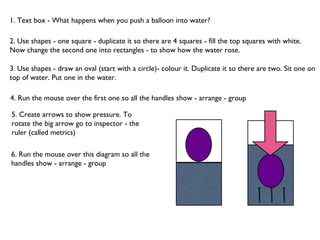
Displacement
- 1. 1. Text box - What happens when you push a balloon into water? 2. Use shapes - one square - duplicate it so there are 4 squares - fill the top squares with white. Now change the second one into rectangles - to show how the water rose. 3. Use shapes - draw an oval (start with a circle)- colour it. Duplicate it so there are two. Sit one on top of water. Put one in the water. 4. Run the mouse over the first one so all the handles show - arrange - group 5. Create arrows to show pressure. To rotate the big arrow go to inspector - the ruler (called metrics) 6. Run the mouse over this diagram so all the handles show - arrange - group
- 2. The balloon is floating. It is full of air. The balloon is being pushed down by my hand. It is full of air. The water is trying to push the balloon back up. It was hard to keep the balloon under the water. The water is 111 cm high The balloon is pushed into water. It pushes the water away. The water goes up 64cm. The water is 175 cm high What happens when you push a balloon into water? Scientists use the word displacement to describe this idea.
- 3. How much space does a balloon take up in the water? Our method: 1. We filled a container with water - the water was right at the top. 2. We put the container in a large bowl. 3. We gently pushed the balloon into the container using a flat board. 4. We poured the water that overflowed in a measuring jug. 5. The amount of water displaced was 1000mls This balloon used 1000mls of space.
- 4. WALT: REMEMBER: DARK BACKGROUND / LIGHT TEXT LIGHT BACKGROUND / DARK TEXT 1. duplicate our text boxes - this will save time 2. Use bold to highlight key information 3. Insert a photo 4. Use comic life to create a speech bubble with the word Eureka in it and then export it into our slide show.
- 5. 1. Weigh an object. 2. Carefully put the object in a full bucket of water. Make sure the bucket of water is sitting in a large bowl. 3. Pour the displaced water carefully into a smaller container. 4. Weigh the water. 5. Compare the weights. Hypothesis : If an object weighs LESS than the water it displaces, the object will FLOAT. so...if an object weighs MORE than the water it displaces, the object will SINK. We tested the hypothesis We designed an experiment
- 6. We recorded the results EUREKA! THE HYPOTHESIS IS CORRECT objects weight of the object weight of the water it displaces big candle 1702 grams 1739 grams the candle is lighter the water is heavier The candle FLOATED big rock 1989 grams 1350 grams the rock is heavier the water is lighter The rock SANK tin of tomatoes grams grams the tin is the water is The tin SANK
- 7. 1. Create a yellow text box 2. Duplicate it 2 times and change the colours 3. Line them up so they sit neatly on top of each other 4. Highlight and arrange - group 5. Duplicate this group - two times 6. Line them up so they sit neatly on top of each other - should have 6 text boxes - colour 7. Highlight and arrange - group 8. Duplicate this group - two times 9. Now you have a table of 4 columns 10. We did it like this so each column can appear - adding on to the last column - this means the reader doesn’t get confused with lots of information appearing all at once.
- 8. A famous scientist called Archimedes... CREATE A SLIDE ABOUT ARCHIMEDES